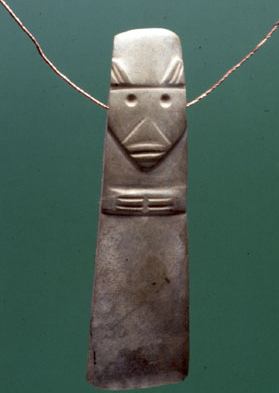A totem pole divided into four sections, depicting from bottom to top: 1) the rectangular base painted in teal;
2) the patron holding in his hands an oar painted in white decorated in the lower part with a grey circle surrounded by black dots and in the upper part with overlapping teal V motifs. The face is painted in brown, the mouth in black, the part around the eye in teal and the eyebrows in black;
3) the eagle with the breast painted in white and grey, the legs in light brown, the wing attachment in light brown and black, the wings in teal and brown, the head in teal, the beak and eyebrows in black and the forehead in brown. The lower part of the bear with the paws painted in teal and part of the body in black and brown.
4) The upper part of the bear with the paws painted in teal, the body in dark brown and black, the head in dark brown and the eyebrows in black. The lower part of the orca with the body painted in white, the head in black, the mouth in yellow and the eye in orange.
5) The upper part of the orca's body painted in black and white. The frog with the legs painted in black, the body and head in teal, the mouth and eyebrows in black and the part around the eyes painted in white. The thunderbird with the body painted in black and white, the head in white and the legs and beak in yellow.
Whale hunter: depicting the client;
eagle: symbolises the noble bird par excellence, hence the power and physical and spiritual abilities of the hunter;
bear: represents the clan to which he belongs;
orca: represents the clan of descent;
frog, bird of thunder: represent the adiutorial spirits par excellence; the frog is represented for its animistic capacities and qualities of being able to live in two worlds, the aquatic and the terrestrial; the bird of thunder, on the other hand, is the sublimal and absolute motif of the positive forces of celestial creative luminosity. Until the end of the 19th century, the erection of a heraldic pole was accompanied by a potlatch; guests acted as witnesses, claiming that the deed was performed by a family that had the right to do so, as the monument was supposed to testify to the social status of the family, documenting its family tree and illustrating its history. Each family, through its myths, boasted a relationship with a spirit that had the appearance of an animal. The carvings representing these spirits were family emblems very similar to a medieval European coat of arms.
Heraldic poles were divided into three categories: 1) for funerary purposes with a wooden urn inside which the ashes were kept;
2) memory poles with the purpose of remembering the dead and the great potlatch festivals;
3) poles placed on beaches or in front of houses to mark property.
Some fulfilled more than one function.
After the spread of iron tools by European traders there was more opportunity to carve heraldic poles and consequently their number also increased. Despite this, the only examples of ancient heraldic poles that are still visible today are those preserved in museums, because being erected outdoors they underwent a process of deterioration and consequent dissolution due to the weather, so their durability was limited.





